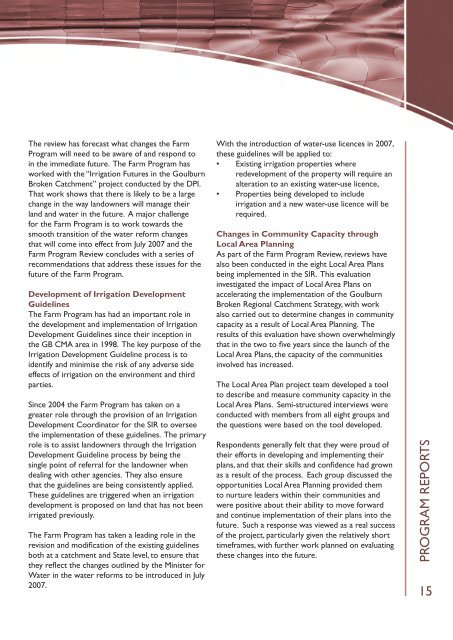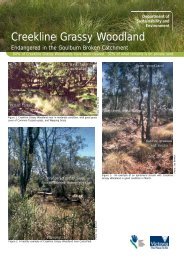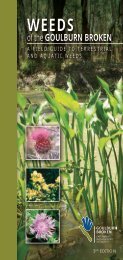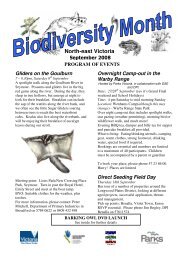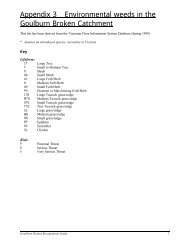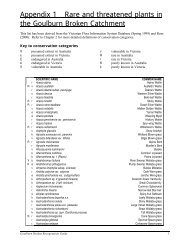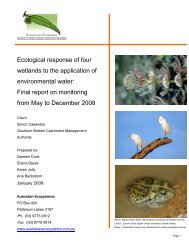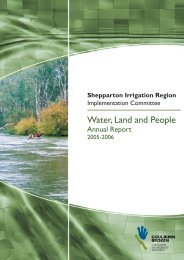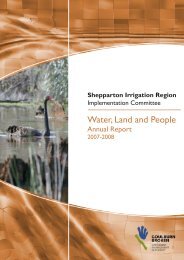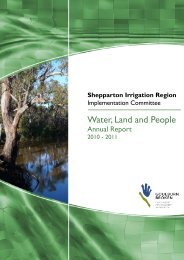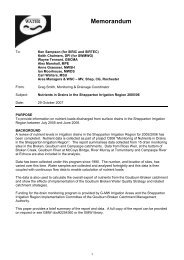Water, Land and People - Goulburn Broken Catchment ...
Water, Land and People - Goulburn Broken Catchment ...
Water, Land and People - Goulburn Broken Catchment ...
Create successful ePaper yourself
Turn your PDF publications into a flip-book with our unique Google optimized e-Paper software.
The review has forecast what changes the Farm<br />
Program will need to be aware of <strong>and</strong> respond to<br />
in the immediate future. The Farm Program has<br />
worked with the “Irrigation Futures in the <strong>Goulburn</strong><br />
<strong>Broken</strong> <strong>Catchment</strong>” project conducted by the DPI.<br />
That work shows that there is likely to be a large<br />
change in the way l<strong>and</strong>owners will manage their<br />
l<strong>and</strong> <strong>and</strong> water in the future. A major challenge<br />
for the Farm Program is to work towards the<br />
smooth transition of the water reform changes<br />
that will come into effect from July 2007 <strong>and</strong> the<br />
Farm Program Review concludes with a series of<br />
recommendations that address these issues for the<br />
future of the Farm Program.<br />
Development of Irrigation Development<br />
Guidelines<br />
The Farm Program has had an important role in<br />
the development <strong>and</strong> implementation of Irrigation<br />
Development Guidelines since their inception in<br />
the GB CMA area in 1998. The key purpose of the<br />
Irrigation Development Guideline process is to<br />
identify <strong>and</strong> minimise the risk of any adverse side<br />
effects of irrigation on the environment <strong>and</strong> third<br />
parties.<br />
Since 2004 the Farm Program has taken on a<br />
greater role through the provision of an Irrigation<br />
Development Coordinator for the SIR to oversee<br />
the implementation of these guidelines. The primary<br />
role is to assist l<strong>and</strong>owners through the Irrigation<br />
Development Guideline process by being the<br />
single point of referral for the l<strong>and</strong>owner when<br />
dealing with other agencies. They also ensure<br />
that the guidelines are being consistently applied.<br />
These guidelines are triggered when an irrigation<br />
development is proposed on l<strong>and</strong> that has not been<br />
irrigated previously.<br />
The Farm Program has taken a leading role in the<br />
revision <strong>and</strong> modification of the existing guidelines<br />
both at a catchment <strong>and</strong> State level, to ensure that<br />
they reflect the changes outlined by the Minister for<br />
<strong>Water</strong> in the water reforms to be introduced in July<br />
2007.<br />
With the introduction of water-use licences in 2007,<br />
these guidelines will be applied to:<br />
• Existing irrigation properties where<br />
redevelopment of the property will require an<br />
alteration to an existing water-use licence,<br />
• Properties being developed to include<br />
irrigation <strong>and</strong> a new water-use licence will be<br />
required.<br />
Changes in Community Capacity through<br />
Local Area Planning<br />
As part of the Farm Program Review, reviews have<br />
also been conducted in the eight Local Area Plans<br />
being implemented in the SIR. This evaluation<br />
investigated the impact of Local Area Plans on<br />
accelerating the implementation of the <strong>Goulburn</strong><br />
<strong>Broken</strong> Regional <strong>Catchment</strong> Strategy, with work<br />
also carried out to determine changes in community<br />
capacity as a result of Local Area Planning. The<br />
results of this evaluation have shown overwhelmingly<br />
that in the two to five years since the launch of the<br />
Local Area Plans, the capacity of the communities<br />
involved has increased.<br />
The Local Area Plan project team developed a tool<br />
to describe <strong>and</strong> measure community capacity in the<br />
Local Area Plans. Semi-structured interviews were<br />
conducted with members from all eight groups <strong>and</strong><br />
the questions were based on the tool developed.<br />
Respondents generally felt that they were proud of<br />
their efforts in developing <strong>and</strong> implementing their<br />
plans, <strong>and</strong> that their skills <strong>and</strong> confidence had grown<br />
as a result of the process. Each group discussed the<br />
opportunities Local Area Planning provided them<br />
to nurture leaders within their communities <strong>and</strong><br />
were positive about their ability to move forward<br />
<strong>and</strong> continue implementation of their plans into the<br />
future. Such a response was viewed as a real success<br />
of the project, particularly given the relatively short<br />
timeframes, with further work planned on evaluating<br />
these changes into the future.<br />
PROGRAM REPORTS<br />
15


